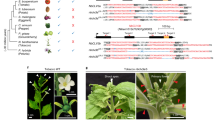Abstract
Flower pigmentation patterns were scored in 185 senseChalcone synthase (Chs) transgenotes and 85 antisenseChs transgenotes; upon first flowering, 139 (75%) of sense transgenotes were found to be phenotypically altered, as were 70 (82%) of the antisense transgenotes. The observed patterns document the range of phenotypic variations that occur, as well as confirm and extend the finding that senseChs constructs produce several types of morphologybased based flower pigmentation patterns that antisenseChs constructs do not. Long-term monitoring for epigenetic variations in one population of 44 senseChs transgenotes showed that 43 (98%) were capable of producing a cosuppression phenotype. The primary determinant of sense-specific patterns of cosuppression ofChs was found to be the repetitiveness and organization pattern of the transgene, not ‘position effects’ by, or ‘readthrough’ from, flanking plant DNA sequences. The degree of cosuppression observed in progeny of transgenotes carrying multiple, dispersed copies as compared to that observed with a single copy of the transgene suggests that sense cosuppression ofChs is subject to a transgene dosage effect.
Similar content being viewed by others
References
de Carvalho F, Gheysen G, Kushnir S, Van Montagu M, Inze D, Castresana C: Suppression of β-1,3-glucanase transgene expression in homozygous plants. EMBO J 11: 2595–2602 (1992).
de Carvalho Niebel F, Frendo P, Van Montagu M, Cornelissen M: Post-transcriptional cosuppression of β-1,3-glucanase genes does not affect accumulation of nuclear mRNA. Plant Cell 7: 347–358 (1995).
Dellaporta SL, Wood J, Hicks JB: A plant DNA minipreparation: version II. Plant Mol Biol Rep 1: 19–21 (1983).
Dorer DR, Henikoff S: Expansions of transgene repeats cause heterochromatin formation and gene silencing inDrosophila. Cell 77: 993–1002 (1994).
Grierson D, Fray RG, Hamilton AJ, Smith CJS, Watson CF: Does co-suppression of sense genes in transgenic plants involve antisense RNA? Trends Biotechnol 9: 122–123 (1991).
Jones JDG, Shlumukov L, Carland F, English J, Scofield SR, Bishop GJ, Harrison K: Effective vectors for transformation, expression of heterologous genes, and assaying transposon excision in transgenic plants. Transgen Res 1: 285–297 (1992).
Jorgensen R: Elicitation of organized pigmentation patterns by a chalcone synthase transgene. In: Amasino RM (ed) Cellular Communication in Plants. pp. 87–92. Plenum Press, New York (1993).
Jorgensen R: Developmental significance of epigenetic impositions on the plant genome: a paragenetic function for chromosomes. Devel Genet 15: 523–532 (1994).
Jorgensen RA: Cosuppression, flower color patterns, and metastable gene expression states. Science 268: 686–691 (1995).
Jorgensen RA, Napoli CA: A responsive regulatory system is revealed by sense suppression of pigment genes inPetunia flowers. In: Gustafson JP, Flavell RB (eds) Genomes, Proceedings of the 22nd Stadler Genetics Symposium, Plenum Press, New York (in press).
Lindbo JA, Silva-Rosales L, Proebsting WM, Dougherty WG: Induction of a highly specific antiviral state in transgenic plants: implications for gene regulation and virus resistance. Plant Cell 5: 1749–1759 (1993).
Matzke MA, Primig M, Tronovsky J, Matzke AJM: Reversible methylation and inactivation of marker genes in sequentially transformed tobacco plants. EMBO J 8: 643–649 (1989).
Matzke MA, Matzke AJM: How and why do plants inactivate homologous transgenes. Plant Physiol 107: 679–685 (1995).
Matzke AJM, Neuhuber F, Park Y-D, Ambros PF, Matzke MA: Homology-dependent gene silencing in transgenic plants: epistatic silencing loci contain multiple copies of methylated transgenes. Mol Gen Genet 244: 219–229 (1994).
MeinsJr. F, Kunz C: Gene silencing in transgenic plants: a heuristic autoregulation model. Curr Topics Microbiol Immunol 197: 105–120 (1994).
Murray MG, Thompson WF: Isolation of high molecular weight plant DNA. Nucleic Acids Res 8: 4321–4325 (1980).
Napoli C, Lemieux C, Jorgensen R: Introduction of a chimeric chalcone synthase gene into petunia results in reversible cosuppression of homologous genesin trans. Plant Cell 2: 279–289 (1990).
Taylor LP, Jorgensen R: Conditional male fertility in chalcone synthase-deficient petunia. J Hered 83: 11–17 (1992).
van Blokland R, van der Geest N, Mol JNM, Kooter JM: Transgene-mediated suppression inPetunia hybrida results from an increase in RNA turnover. Plant J 6: 861–877 (1994).
Author information
Authors and Affiliations
Rights and permissions
About this article
Cite this article
Jorgensen, R.A., Cluster, P.D., English, J. et al. Chalcone synthase cosuppression phenotypes in petunia flowers: comparison of sense vs. antisense constructs and single-copy vs. complex T-DNA sequences. Plant Mol Biol 31, 957–973 (1996). https://doi.org/10.1007/BF00040715
Received:
Accepted:
Issue Date:
DOI: https://doi.org/10.1007/BF00040715




